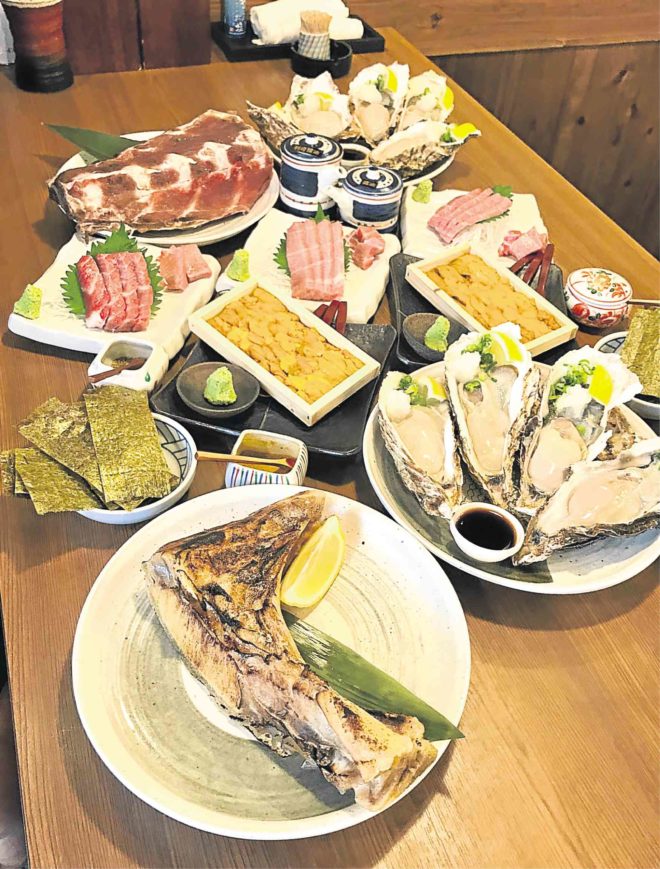
My last trip to Osaka lingers in the mind as one of the most memorable. To my palate, it was a most satisfying experience.
With Kuniyoshi Okamoto of the Tourism Information Office as my guide, I dined in places I would not have been able to, and met many people passionate about food.
This is part 2 of my dining guide to Osaka. With it are some recipes that I taught during my giant bento feast class—inspired by what I ate during my trip.
Tarojiro
This a tempura bar that also serves fresh oysters and sashimi. What we ordered: prawn, snow crab, scallop and shiitake tempura.
The fish and shellfish tempura were bursting with freshness. Each piece was thinly battered and fried in rice oil, thus the lightness which highlighted the natural flavors of the seafood and shiitake.
The oysters were fresh as well—kelp-fed Hokkaido oysters almost the size of my fist. They were plump, meaty and cheesy to the bite.
The torched tuna jaw was fatty, rich and fresh as could be.
The maguro nakaochi consisted of bits of fish meat scraped off tuna bones. The meat closest to the bone was tasty and had a distinct bite and chewiness. We dipped the thin morsels of fresh tuna in soy sauce and wasabi for a different “sashimi kind” of experience.
The otoro and uni were the freshest you could possibly have—sinfully rich and buttery.
Chef Shintaro Fuuki worked in the fish market before opening Tarojiro. He is an expert at procuring the finest and freshest seafood. His friends in the market sell their seafood to him at low prices and deliver them to his doorstep.
Tarojiro is where you should order fresh oysters, as they are sold at half the price compared to many other places.
Tarojiro’s tuna jaw recipe
Season fresh tuna jaw with salt and a bit of pepper.
Torch the tuna jaw until golden and done.
Serve with soy sauce, grated radish and lemon to cut through the fattiness of the tuna.
Kamameshi Yamakura
The stock used to cook the kamameshi rice at Yamakura is made from baby snapper, Japanese vegetables and chicken bone boiled for hours.
What we ordered: duck, salmon, beef and chicken kamameshi. My favorite was the duck, though the beef and salmon were just as delicious.
The rice was full of flavor yet mild and clean on the palate. Every element of the dish could be savored.
Here is a recipe inspired by the salmon kamameshi I had—a simplified yet yummy way of having it.
Salmon rice with ‘ikura’
1 small jar wild salmon roe or ikura
1 tbsp light Kikkoman soy sauce
1 tbsp mirin
1 tbsp sake
Marinate salmon roe for 30
minutes.
Salmon rice
4 rice cooker cups of Japanese rice
4 ½ rice cooker cups of dashi stock
4 ½ cups water
2 tsp dashi powder
2 tbsp butter
2 tsp light soy sauce
1 tbsp white miso
300 g salmon fillet, skin on, scaled, cut into ½ inch cubes
Wash rice.
Combine dashi stock, light soy, salt, butter and white miso. Mix well.
Put rice in a rice cooker and add dashi stock.
Cook.
When water has almost dried out, add cubed salmon and continue to cook until rice is done.
Fluff rice and cap with salmon roe.
Garnish with finely chopped spring onions.
Benitora
This is a Japanese-Chinese fusion restaurant. What we ordered:
Giant gyoza—one of the few types that were to my liking, a mouthful of juicy, meaty and perfectly blended dumplings.
Pork fried rice with preserved mustard greens that paired so well with the giant gyoza.
Here is my gyoza rendition from my bento class.
Giant gyoza
Cabbage:
3 cups Napa cabbage, tender green leaves only, shredded fine
½ tsp salt
Sprinkle salt on cabbage and leave to sit for 20 minutes.
Squeeze leaves dry.
Meat
½ kg ground pork
1/3 cup pork back fat, ground
1 tbsp shiitake mushroom powder
2 tsp grated ginger
2 tbsp sake
1 tbsp garlic paste
3 tbsp green onion, minced
1 tbsp white miso
2 tsp sesame oil
2 tsp sugar
2 tsp Japanese mustard
Dash of white pepper
Pinch salt
Combine cabbage and the rest of the ingredients.
Mix well.
Fill gyoza wrapper (available in Japanese stores) with filling, and seal edges with cornstarch water.
To cook the gyoza:
2 tbsp oil
1/3 cup water
In a nonstick pan add 2 tbsp oil.
Add 12 pieces of gyoza, crimped side up, and wait for the bottom of the gyoza to brown.
Add 1/3 cup water and cover the pan to steam dumplings for 5 minutes.
Remove cover and wait for water to dry out and the bottom of the gyoza becomes crisp again.
Cook the remaining dumplings in the same fashion.
Serve with dipping sauce
Dipping sauce
2 tbsp Kikkoman soy sauce
1/4 cup dashi stock (water and 1 sachet dashi)
3 tsp sugar
3 tbsp rice vinegar
1 tsp chili oil, optional
1 tsp sesame oil
Mix to combine
Hanamaruken Happy Noodle
Don’t miss this place when you’re in Osaka! What we ordered: Pork Rib Ramen, which melted in the mouth like bulalo. The noodles had a firm bite and a deep, intense pork stock.
There were many other specialty restaurants and pastry shops that Kuni-san took us to. Next time you find yourself in Osaka, call him and make tasty memories.
Call +818041421754; visit Kuniyoshi Okamoto on Facebook or follow @toyonaka_bunny on Instagram.

